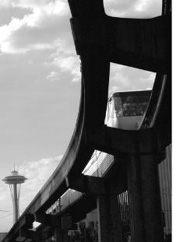MANY POLITICIANS don’t want to reelect the monorail, but just try getting them to say it in public.
Initiative 53 stormed onto the political scene like a runaway train. It took I-53’s volunteer grassroots supporters less than three weeks to gather the 21,000 signatures needed to qualify for the next week’s ballot. Much of the momentum came in reaction to the Seattle City Council’s July 31 vote to strip most of the substantive provisions of the original 1997 Monorail Initiative. Now, Seattleites will decide whether to pony up $6 million to study monorail options and then hold yet another public vote on the resulting plan two years down the road. I-53’s backers say they’ve been unable to get any of the several City Council members who have privately criticized the measure to make their case in a public debate.
I-53 organizer Peter Sherwin says he just wants a detailed study of the monorail proposal’s costs and benefits. Although the 1997 initiative set up a monorail governing body—the Elevated Transit Corp.—that group received only token city funding (a total of $200,000) and no expert staff help during its more than two years in operation.
Sherwin wants to see things done differently the second time around. Initiative 53 would mandate that the city provide $6 million in study funds, which would be used to prepare a new ballot proposal for the 2002 general election. The proposal would also set aside some $125 million in city bond debt as a funding reserve for the monorail.
Because this bond capacity could normally be tapped through a majority vote of council, Sherwin wants to take away the council’s credit card. So where’s the opposition?
Council member Richard McIver is no monorail supporter, but he wants the same thing its backers want—solid cost estimates. “My disappointment with the ETC was that [a real dollar amount] was not an issue they seem to have examined in their two and a half years,” he says. The monorail vision has obviously caught the imagination of voters, said McIver. “I think it’s always going to be hard to beat until you put a price tag on it.”
It’s hard to blame McIver for his lack of enthusiasm about the monorail. Since taking office, the council’s Transportation Committee Chair has seen city voters reject a tax increase for road funding, has had most of his street paving budget disappear due to cuts in state revenues (caused by last year’s state Initiative 695), and has helped the Sound Transit light rail proposal through several political fixes. A monorail may prove to be part of the transportation picture, he says, but it’s hardly his top priority.
McIver also notes that monorail backers originally intimated that private companies might be willing to pick up the tab for system construction—a claim that didn’t pan out.
BUT ETC MEMBERS say private companies were interested. A 1999 request for information drew proposals from 10 companies, but the process stalled after the respondents realized the ETC’s precarious political position, according to monorail backers.
Even the per-mile costs of monorail construction remain vague. One initial estimate said a line could be built for $35 million per mile, but was criticized as unrealistic. City transit planners are estimating a cost of $75 million per mile, a figure that Sherwin calls inflated.
The former members of the ETC board have pledged to return if I-53 is approved, says Tom Carr, an attorney who served as that group’s final chairperson. The ETC board would then oversee the $6 million monorail planning process.
What the final product will look like hasn’t been determined. Although the 1997 initiative called for an X-shaped, 41-mile system serving Seattle’s four quadrants, the ETC’s original study process quickly focused on smaller starter lines, including a downtown circulator proposal. However, in order to keep the monorail from being hijacked by downtown interests, Sherwin has included language in I-53 requiring that any proposed line serve neighborhoods as well as downtown.
The opposition hasn’t quite coalesced. Light rail supporter Roger Pence and former council member Paul Kraabel wrote the “No” statement on I-53 in the city voters’ guide. They argue that elevated trains “won’t work in our city of views” and that neighborhoods would reject the system’s “visual blight and social intrusion.”
Paul Guppy of the Washington Institute Foundation think tank and Puget Sound Business Journal editor Don Nelson argued the “No” position at a recent CityClub forum. Their criticisms mirrored McIver’s: They blasted the lack of cost figures or solid private sector support, while questioning whether Seattle’s neighborhoods will actually welcome the noise and view blockage resulting from an elevated train system. “I simply don’t believe the neighborhoods would stand for this kind of construction,” Nelson says.
According to forum organizers, McIver and council colleagues Heidi Wills and Margaret Pageler were invited to speak, but declined. A Pageler aide said the council member was double-booked at meetings of regional groups and couldn’t attend. McIver’s office cited similar schedule conflicts (including a Sound Transit board meeting) and last-minute notification. Wills simply says that she isn’t opposing the initiative—when I-53 qualified for the ballot, she unsuccessfully tried to convince her fellow council members to enact it into law.
Guppy questioned whether monorail backers can fight City Hall successfully, resulting in the understatement of the debate: “This project does not seem to be building momentum with elected officials in this city.”
Even monorail doubter Nelson reserved a few choice words for the absent politicians from the CityClub dais. “They say we should tear down dams (on the Snake River), which is a ludicrous thing to say,” he said. “Yet they won’t sit up here.”






